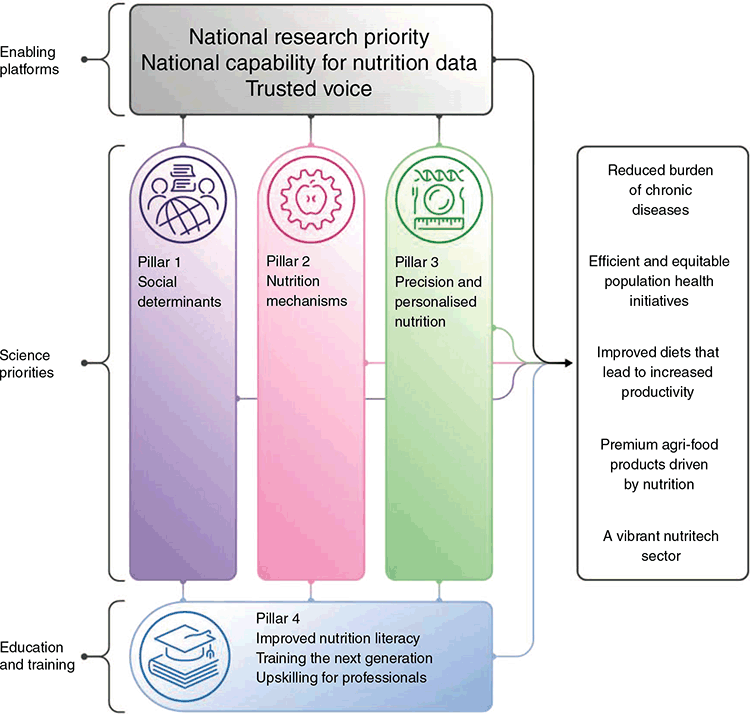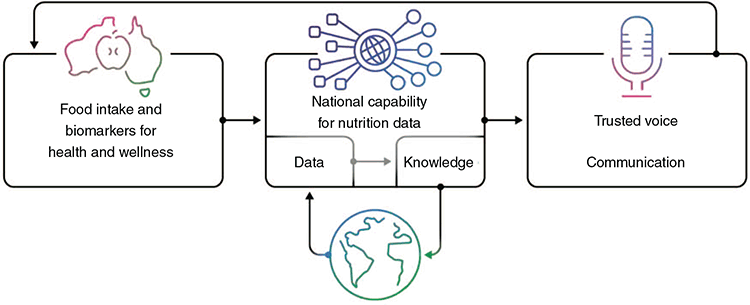Lessons for animal nutrition and production science from the Australian Academy of Science Decadal Plan for the Science of Nutrition
Michael J. Gidley A
A
A Co-Chair, Expert Working Group, Decadal Plan for the Science of Nutrition, Centre for Nutrition and Food Sciences, Queensland Alliance for Agriculture and Food Innovation, Hartley Teakle Building, The University of Queensland, St Lucia, Qld 4072, Australia. Email: m.gidley@uq.edu.au
Animal Production Science 62(12) 1055-1059 https://doi.org/10.1071/AN21151
Submitted: 17 March 2021 Accepted: 21 April 2021 Published: 1 July 2021
Journal compilation © CSIRO 2022 Open Access CC BY-NC-ND
Abstract
The Australian Academy of Science recently released a Decadal Plan for the Science of Nutrition. This plan was focussed on human nutrition, but it is worth considering implications for production animal science and parallels with animal nutrition. One implication for animal production is the need to understand nutrition for health benefits at the whole-of-diet level rather than as a sum of individual foods or nutrients, providing a driver to studies of human food combinations (meals) as well as of feed ingredient interaction effects in animal diets. A second parallel is in the understanding of differences in individual/genotype responses to food/feed. In humans this is termed personalised nutrition and in animals it is becoming a key driver for genetic selection and nutrition management. A third area involves the need for a Trusted Voice in what is a contested media space for both human foods and animal production. While there are different contexts, there remains much that the animal production nutrition and human nutrition communities can learn from each other.
Keywords: nutrition strategy, nutrition mechanisms, nutrition communication, precision nutrition.

|
Professor Mike Gidley is Director of the Centre for Nutrition and Food Sciences (CNAFS) in the Queensland Alliance for Agriculture and Food Innovation at The University of Queensland, Australia. Research themes within CNAFS include: ‘Smart Selections’ (how to identify the right combinations of raw materials and processing to deliver consumer-preferred foods), ‘Naturally Nutritious’ (maximising the intrinsic nutritional properties of agricultural products in foods and ingredients) and ‘Uniquely Australian’ (identifying and validating opportunities for elite products from foods and ingredients that can only have come from Australia). Professor Gidley’s own research is focused on structure–function–nutrition relationships in plant-based foods and ingredients. This has led to the detailed characterisation of starch and dietary fibre digestion and fermentation both in vitro and in vivo, with the understanding generated leading to opportunities for optimising nutritional value of foods and feeds.
Introduction
The science of nutrition is entering an era of opportunity. Improvements in measurement capabilities and complex data analysis, together with advances in theoretical frameworks, cell and molecular biology as well as large-cohort observational studies, provide a backdrop for creating a more complete systems-biology understanding of whole organisms and how they are affected by nutrition. At a societal level, the science of human nutrition is a complex area that involves integrating approaches and ideas across multiple disciplines, including biological, physicochemical, social, agricultural and medical sciences. The target is to discover the mechanisms through which new approaches to improving human health, wellbeing and productivity can be made. The same scientific challenges and opportunities (e.g. improved control of immune systems) are available in the production animal nutrition field, but with different end-points such as improved productivity, meat quality and animal welfare coupled with sustainable use of natural resources.
To provide a view of where the science of (human) nutrition should go in the next few years, the National Committee for Nutrition of the Australian Academy of Science produced a Decadal Plan (National Committee for Nutrition 2019) that is available for download through the Academy’s website (https://www.science.org.au/supporting-science/science-policy-and-analysis/decadal-plans-science/nourishing-australia-decadal-plan). This Plan was drawn up after extensive consultation with the human nutrition sector and relevant stakeholders, and is intended to be owned by the nutrition community and used to shape future priorities and actions. The Plan identified (Fig. 1) three enabling platforms, three science priority pillars, as well as education and training targets aiming at a range of outcomes related to improving long-term health and wellbeing, while delivering social, environmental and economic benefits, including a thriving agri-food sector. The purpose of the present Perspective is to summarise the findings and recommendations from the Decadal Plan and to explore the extent to which they have an impact on the science of production animal nutrition.

|
Enabling platforms
For any science discipline to provide value-for-money for the investment in it, key factors include (a) articulating the importance of the work, particularly to financial stakeholders, (b) effectively and efficiently curating and analysing the data obtained, and (c) communicating outcomes to stakeholders in a credible and consistent manner. In the context of human nutrition, where much of the investment is in the public sector, the Decadal Plan identified that the three corresponding enabling platforms were to work towards nutrition being a national research priority, creating a national capability for nutrition data, and fostering a trusted voice for communication of messages on behalf of the nutrition science community (Fig. 1).
To what extent are these platforms relevant to production animal nutrition? Food production is already an identified national research priority in Australia (Australian Government 2015), so the role that production animal nutrition plays in safeguarding sustainable and profitable meat, egg and milk sectors is, in principle, already a priority, and could arguably be highlighted more prominently. The other two platforms of data capability and trusted voice share some linkages as illustrated in Fig. 2. In the human nutrition sector, there are numerous datasets that are not yet coordinated, limiting the amount of analysis that can be undertaken and frustrating attempts to derive a full systems understanding. Information on, for example, food production, sales, dietary intake and both short- and long-term health, wellbeing and productivity is often held separately and not analysed in a consolidated fashion. The ability to convert data to knowledge is critically dependent on both the quality and accessibility of datasets. Bringing at least relevant public-sector datasets together is a challenge that the National Committee for Nutrition is addressing, with the timeliness due not only to the value of the insights that could be obtained, but also the technical feasibility afforded by advances in data handling and computational systems. The (significant) challenges include developing frameworks for curation, access, governance, ontology or language and global linkages, among others. What are the opportunities in the animal production nutrition area to consolidate and add value to existing national and international datasets?

|
The intense community interest in the links between food intake and health, wellbeing and productivity (such as e.g. mental acuity, sporting prowess) has resulted in a cacophony of voices competing for attention throughout the many and diverse multi-media outlets that individuals engage with. It has always been important to make science-based information on human nutrition available in a credible and convincing form. However, the lack of a single source from which individuals can obtain validated information on food choices and nutrition consequences has recently been brought into focus with the proliferation of ‘information’ from those with vested commercial or ideological interests for whom science is not the yardstick by which content is judged. In the Australian context, the National Committee for Nutrition is building a coalition of relevant parties to establish the basis for developing a sustainable trusted voice. It is critical that this will be seen by the public as being devoid of vested interests. There would seem to be a parallel here with the animal production sector in the area of sustainable and ethical practises. Consumer interest in the environmental impacts of animal production and in the practises of (particularly) intensive production lead to multiple and often conflicting messages that are difficult for individuals to make sense of. What would a trusted voice in the animal production sector look like, and how might it be achieved?
Science priorities
The Decadal Plan identifies three priority pillars (Fig. 1) of (1) social determinants, (2) nutrition mechanisms, and (3) precision and personalised nutrition. Progress in each of these areas can lead to improvements in nutritional outcomes and each has some parallels with production animal nutrition.
Social determinants embrace the science behind ensuring equitable access to nutritious food and enabling people to have the knowledge required to make healthy food choices, and so includes the challenges of accessibility, affordability and acceptability among others. Food accessibility can be limited, particularly in remote regions; so, preservation of, for example, meat while maintaining nutritional value remains important. This can be closely linked to affordability, where the whole foods promoted as being the core of a healthy diet are often more expensive than are less nutritious foods assembled from refined ingredients. This is the ground on which debates around taxes on ‘unhealthy’ foods or subsidies for ‘healthy’ foods take place, often without sufficient science-based evidence. The area of acceptability touches on cultural and environmental factors. At one level, brand loyalty (achieved through advertising) is an important purchase driver for many people, but can be to the detriment of nutrition. At another level, making healthier food choices may not be culturally acceptable. An example is in regions where rice is the main staple. Switching from refined/white rice to wholegrain/brown rice could lead to a major improvement in health outcomes through enhancement of dietary fibre and other nutrient intakes, but is resisted by many for cultural/heritage reasons. A third aspect of social determinants is the relationship between human and planetary health, and it has a clear intersection with animal production nutrition. The science behind a global systems approach to the interactions and trade-offs involved in the use of planetary resources for agriculture and food production will continue to be refined over the next decade, and is likely to affect both societal perceptions (and hence, food choices) as well as government actions to safeguard planetary resources.
Nutrition mechanisms sound like a very traditional science priority, but at least two recent developments (dietary patterns and gut microbiota) are contributing to major re-thinks around the general basis for relationships between food intake and health outcomes. The history of human nutrition science (Mozafarian et al. 2018) shows the emphasis shifting from individual nutrients through foods to dietary patterns. Whereas previous decades have seen emphasis on controlling specific nutrient intakes (e.g. salt, fat, sugar, protein), the consensus health advice from around the world now is to focus on dietary patterns based on whole foods (including lean meat). While the mechanisms of action of individual nutrients and (increasingly) foods have been investigated intensively, much less work has been undertaken on the consequences of combining foods into meals and diets. The assumption has been that nutrition can be assessed by chemical composition, as, for instance, on nutrition information panels on foods or in equations used for constructing many production animal diets. However, this is a great over-simplification that needs to be rectified by science. The ideas of nutritional geometry (Raubenheimer and Simpson 2016) take a first step by charting trajectories of diets in terms of protein to carbohydrate to fat balance, but there is much more to do. One example in humans (and pigs) is the effect of eating meat in the presence and absence of dietary fibre from plant-based foods. In the absence of fibre, any meat that is not digested in the small intestine passes into the large intestine where the resident microbiota use the protein as an energy source, producing several potentially toxic metabolites. However, if digesta from plant-based foods are present at the same time, then the polysaccharides in plant fibre are fermented preferentially by the gut microflora and undigested protein is used as a source of amino acids to produce more ‘good’ carbohydrate-fermenting microbes in pigs (Zhang et al. 2015). More generally the central role of the gut microflora, as influenced by diet, in influencing inflammatory, hormonal and other systemic responses is now beginning to be realised (Zmora et al. 2019), but underlying mechanisms and dietary implications beyond recommendations to ensure sufficient dietary fibre intake are not yet understood. Gut microflora are also a critical factor in monogastric production animal nutrition, with a current focus on limiting the use of in-feed antimicrobials while maintaining animal health and preventing opportunistic pathogen infection of consequence to human health. The ability to characterise gut microflora communities by DNA sequencing is driving mechanistic investigations in this area, with the promise of better future control (Zmora et al. 2019). The current intense interest in the human gut microflora comes several decades after the realisation of the central importance of the rumen microflora in ruminant production animals. Indeed, many of the current concepts around gut microflora ecology and its relationship with feed/food are derived from pioneering studies in production ruminants (Annison and Bryden 1998; Davison et al. 2020). Greater understanding of the microbial ecology of the rumen remains a major priority in animal nutrition, with implications for selection and efficient use of feeds and controlling the production of methane and other greenhouse gases.
Precision and personalised nutrition is a growing trend in human nutrition driven by the realisation that the same diet can affect groups (‘precision nutrition’) or individuals (‘personalised nutrition’) differently. The new science behind this seeks to interpret underlying genetic and lifestyle data with measurements of current health status to prescribe dietary advice. The recent ability to characterise both human and gut microflora genomes is a key driver here, with the scientific challenge of understanding how genetic variations interact with various environmental factors to identify optimal nutrition advice or treatment. There is an interesting contrast here with production animal nutrition in, for example, intensive pig or chicken systems where both genotype and environment are close to constant, so that variations in performance between individual animals may be more related to developmental gene expression patterns rather than to underlying genetics. It is possible that personalised nutrition in humans will have a lot to learn from the understanding gained from investigations of why individual or groups of production animals respond differently to the same feed.
Overall, it is clear that the science of production animal nutrition and of human nutrition are both in an era of opportunity driven by new measurement technologies and the ability to handle large datasets. The underlying science tools and techniques are likely to remain consistent between the two fields, leading to many opportunities for mutual benefit, even though targets for human nutrition and production animal nutrition are often different. Greater sharing of experiences across the two fields has the potential to benefit both communities.
Conflicts of interest
The author declares no conflicts of interest.
Declaration of funding
This research did not receive any specific funding.
References
Annison EF, Bryden WL (1998) Perspectives on ruminant nutrition and metabolism. I. Metabolism in the rumen Nutrition Research Reviews 11, 173–198.| Perspectives on ruminant nutrition and metabolism. I. Metabolism in the rumenCrossref | GoogleScholarGoogle Scholar | 19094246PubMed |
Australian Government (2015) ‘Science and research priorities.’ (Department of Industry, Science, Energy and Resources)
Davison TM, Black JL, Moss JF (2020) Red meat: an essential partner to reduce global greenhouse gas emissions Animal Frontiers 10, 14–21.
| Red meat: an essential partner to reduce global greenhouse gas emissionsCrossref | GoogleScholarGoogle Scholar | 33150007PubMed |
Mozaffarian D, Rosenberg I, Uauy R (2018) History of modern nutrition science: implications for current research, dietary guidelines, and food policy British Medical Journal 361, k2392–k2395.
| History of modern nutrition science: implications for current research, dietary guidelines, and food policyCrossref | GoogleScholarGoogle Scholar | 29899124PubMed |
National Committee for Nutrition (2019) ‘Nourishing Australia: a decadal plan for the science of nutrition.’ (Australian Academy of Science). Available at https://www.science.org.au/supporting-science/science-policy-and-analysis/decadal-plans-science/nourishing-australia-decadal-plan
Raubenheimer D, Simpson SJ (2016) Nutritional ecology and human health. Annual Review of Nutrition 36, 603–626.
| Nutritional ecology and human health.Crossref | GoogleScholarGoogle Scholar | 27296501PubMed |
Zhang D, Williams BA, Mikkelsen D, Li X, Keates HL, Lisle AT, Collins HM, Fincher GB, Bird AR, Topping DL, Gidley MJ, Bryden WL (2015) Soluble arabinoxylan alters digesta flow and protein digestion of red meat-containing diets in pigs. Nutrition 31, 1141–1147.
| Soluble arabinoxylan alters digesta flow and protein digestion of red meat-containing diets in pigs.Crossref | GoogleScholarGoogle Scholar | 26233873PubMed |
Zmora N, Suez J, Elinav E (2019) You are what you eat: diet, health and the gut microbiota. Nature Reviews. Gastroenterology & Hepatology 16, 35–56.
| You are what you eat: diet, health and the gut microbiota.Crossref | GoogleScholarGoogle Scholar |


